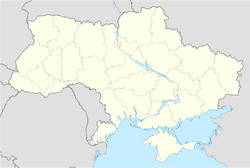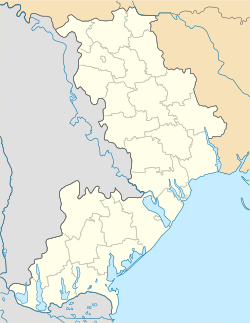| Main | Births etc |
|---|
| Bilhorod-Dnistrovsky Білгород-Дністровський |
|||
|---|---|---|---|
| Akkerman fortress | |||
|
|||
| Coordinates: | |||
| Country | |||
| Oblast | Odessa | ||
| Rayon | Bilhorod-Dnistrovsky | ||
| Area | |||
| • Total | 31 km2 (12 sq mi) | ||
| Elevation | 28 m (92 ft) | ||
| Population (1 January 2011)[1] | |||
| • Total | 50,296 | ||
| Time zone | EET (UTC+2) | ||
| • Summer (DST) | EEST (UTC+3) | ||
| Postal code | 67700—67719 | ||
| Area code(s) | +380 4849 | ||
| Website | www.bilgorod-d.org.ua | ||
Bilhorod-Dnistrovsky (Ukrainian: Білгород-Дністровський|, Romanian: Cetatea-Albă) is a regional city and port situated on the right bank of the Dniester Liman (on the Dniester estuary leading to the Black Sea) in the Odessa Oblast (province) of southwestern Ukraine, in the historical region of Bessarabia. The city serves as an administrative center of the Bilhorod-Dnistrovsky Rayon and a big freight seaport.
Nomenclature[]
The city of Bilhorod-Dnistrovsky is also referred to by alternative transliterations from Ukrainian as Bilhorod-Dnistrovskyi or Bilhorod-Dnistrovskyy. Dnistrovsky was added to differentiate it from Bilhorod that was part of the Sloboda Ukraine and carried a similar name.
- Previous names
- Ophiusa (Οφιούσα), Phoenician colony
- Tyras (Τύρας), Ancient Greek (Classical Greece) colony (also the Greek name for the River Dniester)
- Album Castrum ("White Castle"), Latin name
- Cetatea Albă ("White Citadel"), Romanian name
- Asperon, colony of Byzantine Empire and possible the name deriving from the local Turkic Pecheneg word for "white".
- Maurokastron (Μαυρόκαστρον) / Leukopolis (Λευκόπολις), Koine Greek
- Turla, Turkic
- Montecastro / Asprokastron, colony of Genoa
The town became part of the Principality of Moldavia in 1359 and the fortress is enlarged and rebuilt in 1407 under Alexander the Kind and in 1440 under Stephen the Great.
From 1503 to 1918 and 1940 to 1941, the city was known as Akkerman (Russian: Аккерман), Turkish for "white fortress". From 1918 to 1944 (with a short brief in 1940-1941), the city was known by its Romanian name of Cetatea Albă, literally "white citadel". Since 1944 the city is known as Bilhorod-Dnistrovskyi (Білгород-Дністровський), while on the Soviet geography maps often translated into its Russian equivalent of Belgorod-Dnestrovskiy (Бе́лгород-Днестро́вский), literally "white city on the Dniester".
The city is known by translations of "white city" or "white rock" in a number of languages including Белгород Днестровски (Belgorod-Dnestrovski) in Bulgarian, Akerman (Акерман) in Gagauz, Białogród nad Dniestrem in Polish, and Cetatea Albă in Romanian.
In Western European languages, including English, the city has typically been known by the official name of the time or a transliteration derived from it.
History[]

Ancient Greek colonies on the northern coast of the Black Sea, c. 450 BCE
In the 6th century BC, Milesian colonists founded a settlement named Tyras on the future location of Bilhorod-Dnistrovsky, one which later came under Roman and Byzantine rule. The Byzantines built the fortress and named it Asprocastron ("White Castle" - a meaning kept in several languages). The Voskresensk Chronicle lists Bilhorod "at the mouth of the Dniester, above the sea" among the towns controlled by Kievan Rus.
In 14th century the city was briefly controlled by the Republic of Genoa and by King Louis I of Hungary. Sfântul Ioan cel Nou (Saint John the New), the Patron saint of Moldavia, was martyred in the city in 1330 during a Tatar incursion. In 1391, Cetatea Albă was the last city on the right bank of the Dnister to be incorporated into the newly-established Principality of Moldavia, and for the next century was its second major city, the major port and an important fortress.
In 1420, the citadel was attacked for the first time by the Ottomans, but defended successfully by Moldavian Prince Alexander the Kind.
In 1484, along with Kilia, it was the last of the Black Sea ports to be conquered by the Ottomans. The Moldavian prince Stephen the Great was unable to aid in its defence, being under threat of a Polish invasion. The citadel surrendered when the Ottomans claimed to have reached an agreement with Prince Stephen, and promised safe passage to the inhabitants and their belongings; however, most of the city-dwellers were slaughtered. Later, attempts by Stephen the Great to restore his rule over the area were unsuccessful. Cetatea Albă was subsequently a base from which the Ottomans were able to attack Moldavia proper. In 1485, Tatars setting out from this city founded Pazardzhik in Bulgaria.
It was established as the fortress of Akkerman, part of the Ottoman defensive system against Poland-Lithuania and, later, the Russian Empire. Major battles between the Ottomans and the Russians were fought near Akkerman in 1770 and 1789. Russia conquered the town in 1770, 1774, and 1806, but returned it after the conclusion of hostilities. It was not incorporated into Russia until 1812, along with the rest of Bessarabia.
On 25 September 1826, Russia and the Ottomans signed here the Akkerman Convention which imposed that the hospodars of Moldavia and Wallachia be elected by their respective Divans for seven-year terms, with the approval of both Powers.
In 1918 the city, along with the rest of Bessarabia, became part of Romania after Sfatul Tarii(local parliament) have voted for the unification with Romania. In the interwar period, projects aimed to expand the city and the port were reviewed. Romania ceded the city to the Soviet Union following the 1940 Soviet Ultimatum, but regained it in 1941 during the invasion of the USSR by the Axis forces in the course of the Second World War and had it within its boundaries until 1944 when the Red Army occupied the city once again. The Soviets divided Bessarabia and its southern flanks (including Bilhorod) they became part of the Ukrainian SSR, and after 1991, modern Ukraine.
According to the 2001 Ukrainian census, the majority of the city's population are Ukrainians. The rest are Russians (28%), Bulgarians (4%) and Romanians (2%).
Administrative status[]
Serving as the administrative center of the Bilhorod-Dnistrovskyi Raion (district), Bilhorod-Dnistrovskyi itself is a city of oblast subordinance, thus being subject directly to the oblast authorities rather to the raion administration housed in the city itself. The city also administers two towns Serhiyivka and Zatoka.
People from Bilhorod-Dnistrovskyi[]
- Elena Cernei, Romanian opera singer
- Nicolae Văcăroiu, former Prime Minister of Romania and the former President of Romania (interim)
- Porfiriy Stamatov (1840–1925), Minister of Justice of Bulgaria (1881)
See also[]
- Bilhorod-Dnistrovsky Seaport
Gallery[]
References[]
External links[]
- DP Odessa Apartments: Sights of Ukraine
- Soviet topographic map 1:100,000
- Fortress in Bilhorod-Dnistrovsky
- Excursion to Belgorod-Dnestrovsky fortress
Template:Seven Wonders of Ukraine
Template:Odessa Oblast







